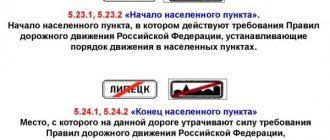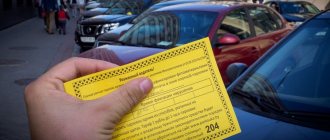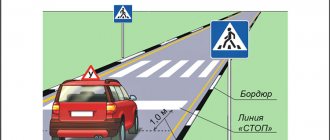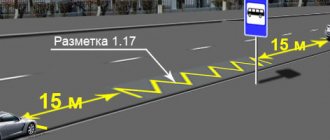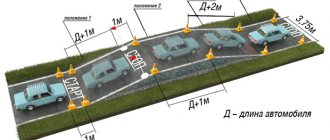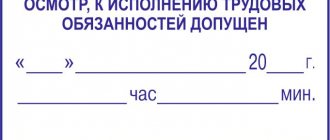To improve the comfort of travel on public transport, legislation provides benefits for buses and minibuses in some parts of the road. For example, in large cities, separate lanes are allocated for public transport, in which other drivers are prohibited from moving. In addition, at all public transport stops there are restrictions on the movement of other cars. From this article you will learn under what conditions drivers can stop and park at bus stops.
Is it possible to stop at a public transport stop?
Before examining cases when it is possible and impossible to be in a public transport stop zone, it is necessary to define the terms used:
- Stop – cessation of movement lasting less than 5 minutes, or associated with loading/unloading a vehicle, boarding/disembarking people.
- Parking/parking – stopping movement for more than 5 minutes, not suitable for other stopping conditions.
It is also necessary to establish what exactly is recognized as a public transport stop. This zone can be marked with a yellow broken line marking (in traffic regulations it is numbered 1.17) or simply with sign 5.16 - a black silhouette of a bus or tram in a white square on a blue background.
Is stopping allowed?
The entire list of circumstances that may prohibit stopping is in paragraph 12.4 of the traffic rules. Among them there are also stopping places for route vehicles. The rules say that drivers are prohibited from stopping not only directly at the public transport stop, but also within a radius of 15 m from them in both directions. The boundaries of the stop must be considered the boundaries of marking 1.17 or the location of the sign 5.16 - another 15 meters must be measured from them.
But the same paragraph of the traffic rules also provides an exception to this regulation: any driver can stop at a bus stop under 2 conditions:
- he needs to pick up or drop off a passenger;
- a stopped car does not interfere with route vehicles.
Is parking allowed?
There is no clause in the traffic rules that would specifically indicate that parking is prohibited at public transport stops. But in paragraph 12.5 of the traffic rules there is a remark that parking is prohibited in any places where stopping is prohibited. Consequently, parking at a bus stop is prohibited, since the conditions when stopping at them are permitted are an exception to the rule, and not the rule itself.
What the rules say about stopping at a bus stop
First, let’s clarify the designation of the concepts “Parking” and “Stop”.
A stop is a deliberate cessation of movement for a period of up to 5 minutes.
No more than 5 minutes are given to board or disembark a passenger, load or unload the car.
According to traffic rules, the concept of “parking” means a complete cessation of movement for more than 5 minutes , when the driver does not intend to disembark or pick up people, or to load or unload.
The stopping place for public transport moving along the route, including passenger taxis, is indicated using markings 1.17 or a sign indicating this place.
Passing vehicles cannot stop closer than 15 meters from the bus or tram parking lot indicated by the sign. Prohibiting cars to stop also means prohibiting them from standing.
Attention! Entry into a bus lane, the name given to a place on the road provided for the passage of route transport, is permitted when the driver’s goal is to pick up and unload passengers at a stop.
The traffic rules, clause 12.4, state that stopping at a public transport stop is allowed if it is necessary for a car passenger.
But provided that the car does not interfere with route public transport. There should not be a 3.27 sign nearby prohibiting cars from stopping. When approaching this place, the bus lane should not be limited by a continuous line.
The bus lane, along with special transport, can also be used by taxis, provided they have supporting documents, special painting, lights and taximeters. For Moscow cars, special “yellow license plates” are required. Taxis can stop at pockets, but they are not allowed to park in these areas.
What if the stop is forced?
Traffic regulations provide for situations where a driver may be forced to stop against his will and the rules themselves. For example, if a car malfunction occurs that prevents safe movement on the road, if the health of the driver or passenger seriously deteriorates, if necessary, to avoid an emergency. Any of these reasons makes the stop forced, which means that it should not be punished, even if it was made in violation of traffic rules.
However, in practice, not everything is so simple: in order for a stop to be legally recognized as forced, other conditions must be met: hazard lights are turned on, an emergency stop sign is displayed. In this case, the driver will not be punished, even if his car interferes with the passage of other vehicles. If the driver decides to turn on only the emergency lights, without placing the required sign behind the car, then the stop will not be recognized as forced, which means they will issue a fine, which will be quite difficult to challenge.
Is it possible to stop at a bus stop?
Is it possible to stop at a public transport stop and is it possible to drop off passengers at a bus stop?
However, there is a nuance that makes it possible to stop in a prohibited place. This is indicated in clause 12.4 of the traffic rules.
It states that stopping is allowed for no more than 5 minutes if:
- it is necessary to disembark or pick up a passenger;
- load or unload cargo.
At the same time, the car should not interfere with the movement of public transport.
Exceptions can include emergency braking caused by a vehicle malfunction, an accident that occurred in the area of the stop, dangerous cargo or poor health of the driver.
In all of these cases, it is necessary to correct the damage as quickly as possible by installing a warning triangle. Release her as quickly as possible.
All other situations are not exceptions and are subject to penalties.
It is important to remember the signs: if sign 3.27 is installed and/or continuous markings are applied, parking is prohibited under any circumstances.
What is the fine for stopping or parking near a bus stop?
Responsibility for stopping with traffic violations is enshrined in Art. 12.19 Code of Administrative Offences.
In the described case, it is necessary to consider 3 of its points:
- clause 3.1 – stopping closer than 15m from a bus stop is punishable by a fine of 1000 rubles.
- clause 4 – stopping on the road that interferes with other road users will result in a fine of 2,000 rubles.
- clause 6 - the same violations committed in Moscow or St. Petersburg are punished a little more severely - a fine of 3,000 rubles.
In addition to a fine, drivers who leave their cars at a bus stop will face an even bigger problem - having their car towed. At the same time, if a tow truck with a loaded car has already started moving, then the violator can only resign himself and subsequently pay the fine, the services of the tow truck, and the maintenance of the car in the impound lot.
Stopping and parking at bus stops: rules, fines, nuances
A public transport stop is a dangerous zone, where many people constantly accumulate, and minibuses, buses, and trolleybuses also stop.
Unfortunately, many drivers of passenger vehicles forget about the prohibition of stopping and parking in these places, creating additional obstacles and increasing the danger of the area. And while some do this consciously, some drivers are simply not aware of the rules that apply to bus stops.
Parking and valet parking at the bus stop
Paragraph 12.4 of the traffic rules indicates that parking and parking on the territory of a bus stop is prohibited. The same rule applies to the adjacent area - 15 meters before and the same after the stop. The distance is measured from sign 5.16 or road markings.
What does the concept of “parking” mean? This is when the car is stationary for more than 5 minutes. In this case, the driver may be in the car or absent. Parking is defined as parking for a period exceeding 5 minutes, regardless of engine operation.
Is stopping allowed?
Stopping involves short-term parking (up to 5 minutes). But even this is prohibited at bus stops. There are only two exceptions provided for in paragraph 12.4 of the traffic rules:
- Boarding or disembarking passengers.
- Loading or unloading things.
Stopping is permitted provided that the car does not interfere with public transport and waiting people.
The listed rules apply not only to passenger cars, but also to other buses that are not public transport. For example, corporate transport from a factory can drop off passengers at a bus stop, and this will not be considered a violation.
But there is one important condition - stopping is allowed provided that there is no sign 3.27, which prohibits any type of stop, even to disembark passengers
When is there no fine?
There are several situations when stopping or even parking at a bus stop is not considered a violation, and the driver does not face a fine. This:
- the driver is feeling unwell (for example, he has a heart attack or suddenly darkened his vision);
- maneuver to prevent an accident (for example, when a car drifts into the oncoming lane);
- car breakdown requiring an emergency stop.
In any of the above cases, the driver must stop, put up a warning triangle and correct the problem. If the driver becomes ill, you need to signal to other road users or pedestrians.
In case of any breakdowns you can stop in the wrong places:
- malfunctions of the steering or brake system;
- windshield wiper malfunctions in bad weather;
- malfunction of lighting devices (especially at night).
The listed breakdowns are a good reason for parking and troubleshooting. If necessary, you can call a tow truck or a mobile team of auto mechanics.
Punishment for violation
And now about the punishment for violating parking rules at bus stops. It is provided for in Article 12.19 of the Code of Administrative Offenses:
- Stopping or parking without interfering with public transport - 1000 rubles;
- Parking obstructing pedestrians or public transport - a fine of 2,000 rubles.
In Moscow and St. Petersburg, the fine for these offenses is higher - 3 thousand rubles.
But a fine is not the only punishment provided for the violator. If the driver parks at a stop and leaves the car, the car will be towed to the impound lot. In this case, you will have to pay significantly more. At the same time, you may only be gone for a few minutes - the traffic police and tow trucks work quickly - 10 minutes is enough to detain a car.
What should I tell the inspector?
If you violated traffic rules and parked at a bus stop or less than 15 meters before or after the sign, your actions depend on the reason for such a maneuver. The traffic police inspector who approaches will need to explain that the car is broken. Be prepared to prove it - the police don't take your word for it.
If there is no valid reason for stopping, you should expect a report and a fine to be drawn up. The traffic police inspector will have to record the violation and collect testimony from witnesses. In this case, it is almost impossible to avoid punishment. To avoid paying fines, you need to follow traffic rules and not ignore the signs.
What to do if a fine is issued?
A fine for stopping at a bus stop can be issued by both an inspector and an automatic camera for recording violations. If an employee of the State Traffic Inspectorate does this personally, and the driver is confident that he is right (for example, when the car is 15 meters from the stop or when the driver slowed down to pick up a passenger), then the motorist can try to convince the inspector that there is no violation on the spot. This will be the simplest solution to the problem, since appealing a fine to the traffic police or court is much more difficult.
If the driver agrees with the punishment, he must pay the fine within 60 days, 20 of which a 50% discount will apply. After 60 days, the amount of the fine may double in accordance with Article 20.25 of the Code of Administrative Offences.
Is stopping at a bus stop allowed?
Is it possible to stop and drop off passengers at a bus stop? The traffic rules ( clause 12.4 ) indicate that you cannot stop here. This rule also applies to the entire stopping area - 15 meters and taxi stops. Bus stops are marked with a special sign and road markings that every driver knows.
The specified interval of 15 meters is calculated from the installation location of the corresponding road sign . If it is not there, then from the marking or pocket designation .
ATTENTION The stopping area is 15 meters . also applies it if the width of the roadway is less than 15 meters .
Despite the fact that traffic regulations clearly state that parking is prohibited at public transport stops, there are still drivers who violate it and receive appropriate penalties.
Is it possible to park at bus stops?
Parking rules are enshrined in the Code of Administrative Offenses of the Russian Federation. If a motorist ignores the instructions of the “No Stopping” sign, he may be subject to administrative liability. The amount of recovery is fixed and amounts to 1000 rubles. Moreover, we are talking not only about parking in a place intended for stopping public transport, but also within a radius of 15 meters from it.
A more severe punishment awaits those motorists who leave their cars at public transport stops, thereby creating an obstacle to the movement of other vehicles. The amount of recovery in this case will be 2000 rubles. In Moscow and St. Petersburg, fines for such violations will be even higher.
The driver may stop within the sign's coverage area only to pick up or unload passengers.
Responsibility for parking at stops in Moscow and St. Petersburg
Since these cities have a special legal status, the amount of fines here is set by the local government. Particular attention is paid to violations of parking rules, since this problem is especially acute in large cities.
If a driver parks at a bus stop in the capital or in St. Petersburg, he faces a fine of 3,000 rubles.


